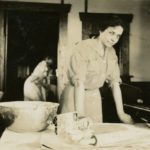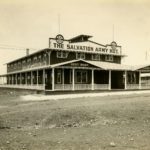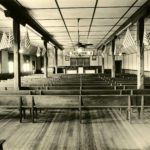
Looking After the Troops at Home
Huts and hostels were established by The Salvation Army on or near stateside U.S. military camps. They provided servicemen with the comforts of home, including nourishing meals, a quiet place to write letters, clothing repair and, most importantly, spiritual enrichment.
Stateside hut buildings were permanent structures. A standard hut measured 65 feet wide by 120 feet deep. The ground floor contained large social halls with writing desks, tables, a library, and an auditorium where religious services and entertainments were held. Servicemen had magazines, games, a record player, and a piano available for their use.
A “Coffee Ann” provided refreshments, including doughnuts, for a small charge. The second floor contained living quarters for staff along with furnished bedrooms for visiting soldiers’ relatives. Altogether, 13 huts and hostels were in operation stateside.





